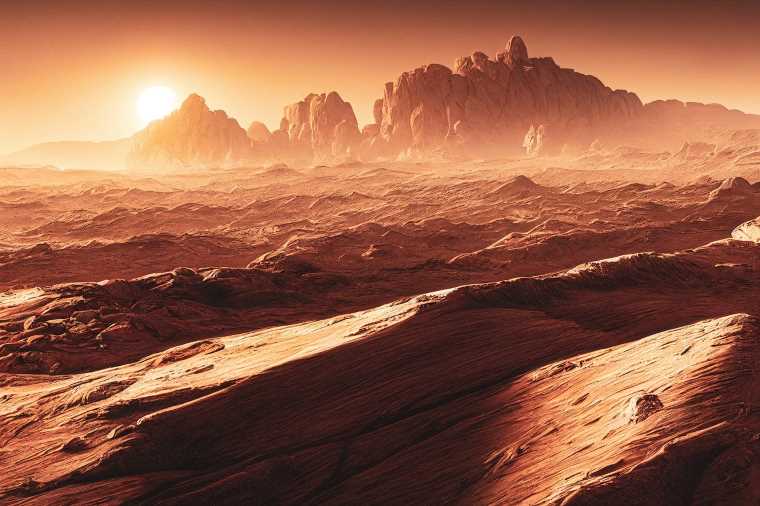Dutch researchers have found evidence of approximately 20 mysterious, large-scale structures hidden beneath the sediment of an ancient lost ocean on Mars. The team also reports the discovery of evidence that an active Martian crust is pushing against Olympus Mons, elevating the solar system’s largest volcano.
Previous scientific efforts have found hidden ice deposits and other unexpected structures on the red planet. However, the researchers behind this latest discovery say these mysterious, large-scale structures are particularly perplexing because they appear hidden beneath the sedimentary layers of an ancient ‘lost’ Martian ocean.
“These dense structures could be volcanic in origin or could be compacted material due to ancient impacts,” explained Dr. Bart Root of Delft University of Technology (TU Delft), who presented the team’s findings at the Europlanet Science Congress (EPSC) in Berlin. “There are around 20 features of varying sizes that we have identified dotted around the area surrounding the north polar cap – one of which resembles the shape of a dog.”
“There seems to be no trace of them at the surface,” the researcher added. “However, through gravity data, we have a tantalizing glimpse into the older history of the northern hemisphere of Mars.”
Mysterious, Large-Scale Structures Revealed by Gravity Map
Dr. Root and colleagues from Utrecht University initially set out to use tiny variations in the orbits of Martian satellites caused by gravitational differences of varying materials within the planet’s crust to make a gravitational map. This data was added to computer models containing data collected by NASA’s Mars Insight mission on the Martian crust’s flexibility and thickness. Combined with data on the dynamics of Mars’ mantle and the planet’s deep interior, the team successfully created a global density map of the entire planet.
When examining their newly created gravity map, the team noticed a group of mysterious structures in the planet’s northern polar regions. According to the researchers, these large-scale mysterious structures are approximately 300-400 kg/m3 denser than their surroundings. The structures are not visible from the surface but instead appear to have been buried in the planet’s ancient past beneath the remnants of a large ocean.


Another mystery revealed by the team’s gravity map involved large structures underneath the huge volcanic region of Tharsis Rise. Known for its preponderance of volcanoes, the area is also home to the solar system’s largest volcano, Olympus Mons.
“Although volcanoes are very dense, the Tharsis area is much higher than the average surface of Mars and is ringed by a region of comparatively weak gravity,” according to a statement announcing the study. “This gravity anomaly is hard to explain by looking at differences in the Martian crust and upper mantle alone.”
According to the researchers, a “light mass” of around 1750 kilometers across and at a depth of 1100 kilometers appears to be actively pushing up on the entire Tharsis region. They suspect this light mass could be a massive plume of lava hidden deep within the Marin interior that is slowly working toward the surface. Root says this information may show that Mars is still active beneath the planet’s outer surface.


“The NASA InSight mission has given us vital new information about the hard outer layer of Mars,” he explained. “This means we need to rethink how we understand the support for the Olympus Mons volcano and its surroundings.”
Mars Quantum Gravity Mission Could Solve the Mystery
Next, Root has joined a team proposing a Mars Quantum Gravity (MaQuis) mission. In that proposal, the team says that an ideal mission would include similar technology to that used by the GRAIL and GRACE missions, which were designed to map the Moon’s and Earth’s gravity, respectively. The mission could also help the team solve the true nature of the mysterious, large-scale structures hidden beneath the Martian surface.
“Observations with MaQuIs would enable us to better explore the subsurface of Mars,” said Dr. Lisa Wörner of DLR, who presented on the MaQuIs mission at EPSC2024. “This would help us to find out more about these mysterious hidden features and study ongoing mantle convection, as well as understand dynamic surface processes like atmospheric seasonal changes and the detection of ground water reservoirs.”
Christopher Plain is a Science Fiction and Fantasy novelist and Head Science Writer at The Debrief. Follow and connect with him on X, learn about his books at plainfiction.com, or email him directly at christopher@thedebrief.org.

